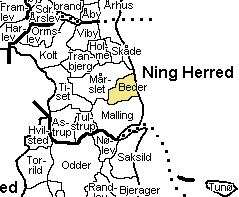Parish (Denmark)
A parish (sogn) in Denmark is a local ecclesiastical region (parish) that was formerly an administrative territorial unit of the country. Beginning in 1645, Danish pastors were required to maintain a parish register, which in modern times has become a valuable tool for genealogical research.[1]
Danish parishes originated in the Middle Ages. Until the municipal reform of 1970, they were local units of governmental administration. In 1870, there were 1097 parish communities (sognekommuner). In 1970, there were more than 1300, and this number was reduced by the municipal reforms to 277 municipalities.[2] Since 1970, a municipal community often comprises multiple parishes.
Even in the present day, the original parish boundaries still play a significant role, for example in determining community boundaries and school districts.
Hierarchy

Until 1970, a parish made up part of a hundred, which was part of a county.
References
- ↑ "Parish Registers". The State Archives. Retrieved 2014-04-07.
- ↑ "Kommunalreformen 1970" (in Danish). Dansk Center For Byhistorie. Retrieved 2014-04-07.